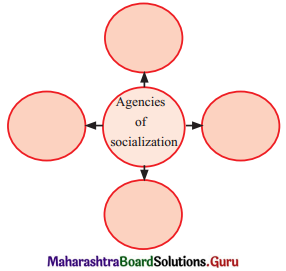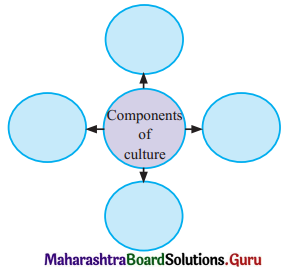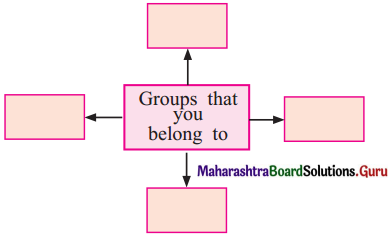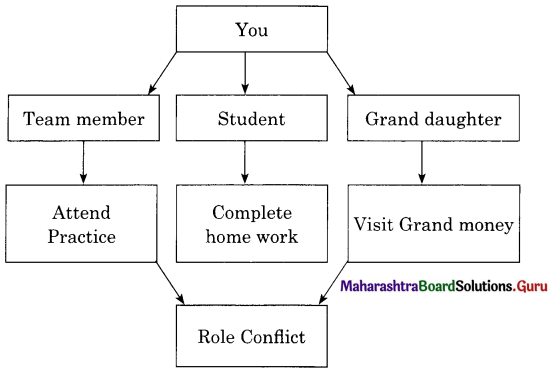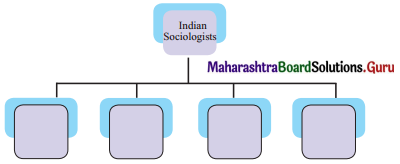Balbharti Maharashtra State Board Class 11 Sociology Solutions Chapter 7 Social Stratification Textbook Exercise Questions and Answers.
Maharashtra State Board Class 11 Sociology Solutions Chapter 7 Social Stratification
1. (A) Choose the correct alternative and complete the statements.
Question 1.
Social stratification is ……………….
(local / national / universal)
Answer:
universal
Question 2.
Class is a ………………. form of stratification.
(open / closed / rigid)
Answer:
open
![]()
Question 3.
Gender based stratification has led to ………………. in society.
(justice / exploitation / equality)
Answer:
exploitation
Question 4.
Social stratification of ………………. is based on the principle of purity and pollution.
(class / gender / caste)
Answer:
caste
1. (B) Correct the incorrect pair.
Question 1.
(a) Ownership of wealth – Economic Capital
(b) Membership and involvement in social network – Social Capital
(c) Gained through education – Cultural Capital
(d) Prestige, status and social honour – Economic Capital
Answer:
(d) Prestige, status, social honour – Symbolic Capital
1. (C) Correct underlined words and complete the sentence.
Question 1.
Caste is based on wealth.
Answer:
Class is based on wealth.
Question 2.
A hierarchical system where women are given a lower social status is stratification based on class.
Answer:
A hierarchical system where women are given a lower social status is stratification based on gender.
![]()
2. Write short notes.
Question 1.
Principles of social stratification.
Answer:
- Stratification is social: Social stratification is not determined by biological differences but it is governed by social norms and sanctions.
- Social stratification persists over generations : In all society’s parents confer their social status on their children. Thus, the pattern of inequality stays same from generation to generation.
- Social stratification is universal but variable : Social stratification is found everywhere. At the same time the nature of inequality varies. ‘What’ is unequal and ‘how’ unequal, changes within the context of a society.
- Social stratification involves inequality : Any stratified system not only gives people more resources but also justifies this arrangement and defines them as fair.
- Social stratification is consequential : Stratification affects every aspect of life of all individuals. Social life is affected because of the position of an individual in the social hierarchy. Some experience positive consequences, while others face negative consequence of the hierarchy in a particular society.
Question 2.
Characteristics of caste according to Dr. G.S. Ghurye.
Answer:
Dr. G.S. Ghurye a well known Sociologist and Indologist defines caste in terms of its essential characteristics. They are as follows:
1.Segmental division by society : Society is divided into various castes. The membership of castes are determined by birth. Therefore, mobility from one caste to another is impossible.
2. Hierarchy: Castes or segments are arranged in terms of hierarchy. According to Dr. Ghurye, castes are graded and arranged into a hierarchy on the basis of the concept of ‘purity and pollution’.
3. Restriction on feeding and social intercourse : This fact of separation is reinforced by the notion of ‘purity and pollution’. Each caste imposes restrictions on its members with regard to food and social intercourse.
4. Differential civil and religious privileges and disabilities : In a caste society there is an unequal distribution of privileges and disabilities among its members. The higher castes enjoy all privileges and lower caste suffer from all kinds of disabilities.
5. Lack of unrestricted choice of occupation : Choice of occupation is not free under caste system. Occupations are hereditary and the members of the caste are expected to follow their traditional occupation.
6. Endogamy : Endogamy is the essence of caste system. Every caste of sub-caste insists that its member should marry within the group.
![]()
Question 3.
Types of mobility.
Answer:
1. Horizontal Mobility : It refers to change of residence or job without status change. Under this type of social mobility, a person changes one’s occupation but the overall social standing remains the same. Certain occupation like doctor, engineer and teacher may enjoy the same status but when an engineer changes one’s occupation from engineer to teaching engineering there is a horizontal shift from one occupational category to another but no change has taken place in the system of social stratification.
2. Vertical Mobility : Vertical mobility refers to any change in the occupational, economic, political status of an individual or a group which leads to change of their position. Vertical Mobility stands for change of social position, either upward or downward.
3. Intergenerational Mobility : This type of mobility means that one generation changes its social status in contrast to the previous generation. However, this mobility may be upward or downward. For e.g., people of lower caste or class may provide facilities to their children to get higher education, training and skills, with the help of which the younger generation may get employment in higher position.
4. Intragenerational Mobility : This type of mobility takes place in the lifespan of one generation. A person may start one’s career as a clerk and after acquiring more education, becomes an IFS Officer. Here the individual moves up and occupies a higher social position than previously.
3. Differentiate between.
Question 1.
Caste and Class.
Answer:
| Caste | Class |
| (i) Different castes form a hierarchy of social preference and each position in the caste structure is defined in terms of its ‘purity and pollution’. | (i) A social class is made up of similar social status who regard one another as social equals. |
| (ii) In a caste stratification system, an individual’s position depends on the status attributes ascribed by birth. | (ii) In a class stratification system and individual’s position depends on the possession of substantial amounts of wealth, occupation, education and prestige which is achieved. |
| (iii) Caste is an example of closed stratification. | (iii) Class system is an example of open stratification. |
| (iv) In this type of social stratification there is no scope for social mobility. | (iv) In this type of social stratification there is scope for social mobility. |
![]()
Question 2.
Intragenerational Mobility and Intergenerational Mobility.
Answer:
| Intragenerational Mobility | Intergenerational Mobility |
| (i) This type of mobility takes place in the lifespan of one generation. | (i) This type of mobility means that one generation changes its social status in contrast to the previous generation. |
| (ii) This mobility is upward. | (ii) The mobility may be upward or downward. |
| (iii) A person may start one’s own career as a clerk. He / she acquires more education and over a period of time becomes an IFS Officer. Here the individual moves up and occupies a higher social position than previously. | (iii) People of lower caste or class may provide facilities to their children to get higher education, training and skills. With the help of these skills the younger generation may get employment in higher position. |
| (iv) It refers to advancement in one’s social level during the course of one’s lifetime. | (iv) It refers to a change in the status of family members, one generation to the next. |
4. Explain the following concept with suitable examples.
Question 1.
Vertical Mobility
Answer:
- Vertical mobility refers to any change in the occupational economic or political status of an individual or a group which leads to change of their position.
- Vertical mobility stands for change of social position either upward or downward, which can be labelled as ascending or descending type of mobility.
Example : A person who works as a customer assistant, works hard and starts his own business successfully. In such a position there is a clear change in the position of the individual.
Question 2.
Intergenerational Mobility
Answer:
- This type of mobility means that one generation changes its social status in contrast to the previous generation.
- However, this mobility may be upward or downward.
Example : People of lower caste or class may provide facilities to their children to get higher education, training and skills, with the help of which the younger generation may get employment in higher position.
5. (A) Complete the concept maps.
Question 1.

Answer:

![]()
5. (B) State whether the following statements are true or false with reasons.
Question 1.
There is no mobility in the class system.
Answer:
This statement is False.
- Class system is an example of open stratification in which individuals or groups enjoy the freedom of changing their social strata, i.e., in class system there is scope for social mobility. Individuals or groups move from one strata to another.
- The class system in modern industrial society (Upper class, middle class and lower class) is an example of open stratification.
- The criteria of open stratification i.e., class system are power, property, intelligence, skills, etc.
Question 2.
Education had led to women’s empowerment.
Answer:
This statement is True.
- Education is a milestone of women empowerment because it enables them to respond to challenges, to confront their traditional role and change their life.
- Education creates occupational achievement, self-awareness, satisfaction etc.
- Education is one of the main levers of social class which has helped women empower and change their status in society.
6. Answer the following in detail (About 150-200 words).
Question 1.
Discuss class and gender as forms of social stratification with suitable examples of your own.
Answer:
Class as a form of social stratification:
A social class is made up of people of similar social status who regard one another as social equals.
Each class has a set of values, attitudes, beliefs and behaviour norms which differ from those of the other classes. A social class is essentially a status group which is achieved. Class is almost a universal phenomenon. Each social class has its own status in the society. Status is associated with prestige. A social class is relatively a stable group. Social class represent an open social system. An open class system in one in which vertical social mobility is possible.
Example : Within this system, individuals can move from one class to another through hard work, education and skills. Ownership of wealth and occupation are the chief criteria of class differences but education, hereditary, prestige, group participation, self identification and recognition by others, also play an important role in class distinction.
Gender as a form of social stratification:
Gender stratification refers to social ranking, where men typically inhabit higher statuses than women. A common general definition of gender stratification refers to the unequal distribution of wealth, power and privilege between the two sexes. Throughout the world, most societies allocate fewer resources to women than men. Almost all societies are characterized by sexism. Sexism is the belief that one sex is superior than the other. Although, societies have been believing in the superiority of men over women and therefore have been dominating women. This male dominance is supported further by patriarchy. The process of socialization is gendered and creates gender hierarchy. Example : Boys are given toy cars or lego sets or bat and ball to play whereas girls are given household sets, medical sets, dolls, etc.
![]()
11th Sociology Digest Chapter 7 Social Stratification Intext Questions and Answers
ACTIVITY (Textbook Page No. 75)
Question 1.
Watch the Marathi movie, ‘Fandry’ and write a film review describing the social, cultural and economic obstacles created by caste barriers.
Answer:
Review of the Marathi Movie ‘Fandry’. The film powerfully busts the myth of individual merit in a caste-decided society. In a small village in Maharashtra Jabya portrays friend Pirya are the only two boys from a so-called untouchable caste. Jabya doesn’t want to consider his caste an obstacle to his aspirations. These hopes of wanting to move out of the confines of his caste are shown through Jabya’s love for his classmate Shalu, an upper caste by birth. Jabya and Pirya, meanwhile want to hunt down the exclusive black sparrow which Jabya believes would help him to win Shalu’s love. His father Kachru wants him to continue their tradition. From being called blacky to being made to feel ashamed of his mother’s occupation. When she comes to school Jabya’s trials indicate the prejudices that make the promise of equality sound like unreal.
In theory, Jabya’s school is supposed to uplift him to a modern and caste-less society where he should be able to choose the work he wants to do. Yet we see how modern education itself is not free from caste. In caste system social set up everything is pre-decided by one’s caste, whom one can love and be friends with, the occupation he has to choose etc. Fandry makes visible the way in which caste is so central to all our relatives.
Question 2.
In today’s world the characteristics of caste are changing. Find out which of the characteristics are changing and which are remaining constant. Conduct a group discussion on the same. (Textbook Page No. 75)
Answer:
In the modern age, many changes happen in the features and functions of caste system. A group discussion can be conducted on the following changes within the caste system.
- Decline in the superiority of upper caste.
- Changes in the restrictions regarding social habits.
- Changes in the restrictions regarding marriage.
- Changes in the restrictions regarding occupation.
- Changes in the disabilities of lower castes.
- Loss of faith in the ascribed status.
- Changes in lifestyle.
- Changes in inter-caste relations.
- Changes in the lower of caste Panchayats.
- Restrictions on education removed
- Changes in the philosophical basis.
![]()
Question 3.
Divide the class into groups. Each group can select one of the issue mentioned and collect information on it. The group should present their findings to the class. (Textbook Page No. 78)
Answer:
Present findings on any one of the issues to the class.
1. The Economy : Explains how women are being paid low for some amount of work done by men in various unorganized sectors. Also, dual role played by women and unpaid work.
2. The Polity : Explains about women exercising the power of right to vote, in spite of reservation for women, the number of women in official positions of power are less as world leaders, less number of women at war and peace movements.
3. Crime : Explains the crime committed by women, increase in number of women coming in conflict with the law; women prisons in India are relatively less crowded, women commit fewer and different crimes compared to men.
4. Religion : Most religions elevate the status of men over women and have striker sanctions against women and require them to be submissive.
5. Family : In spite of women sharing the economic role, the role of men in raising children is still minimum or negligible. Traditional sexual division of labour where women looked after the house and men played the role of economic provider is still prevalent in the society. Women are expected to balance between home and work.
6. Health : Women neglect their health and nutrition. The frequency of women to visit a doctor is very less as most of the time they manage with home remedies.
Question 4.
Find out examples of intergenerational and intragenerational mobility from your surroundings and present it in your classroom.
Answer:
1. Intergenerational mobility means one generation changes its social status in contrast to the previous generation.
Example : Eminent personality like Dr. B. R. Ambedkar.
2. Intragenerational mobility this type of mobility takes place in the life span of one generation. Example : A person may start one’s career as a clerk and after acquiring more education over a period of time he becomes an IAS officer. Students should find out similar examples of intergenerational and intragenerational mobility from their surroundings.
![]()
Question 5.
Arrange the group reading of any two of the following books and conduct a group discussion on the caste and gender discrimination/inequality Baburao Bagul-Jevha Mi Jaat chorli Hoti, Daya Pawar- Baluta, Urmila Pawar- Aaydaan, Omprakash Valmiki- Jhootan, Kishor Shantabai Kale- Against all Odds. (Textbook Page No. 81)
Answer:
Baburao Bagul – ‘Jevha Mi Jaat Chorli Hoti’: This most poignant story recites about an educated Dalit trying to escape his caste profession of scavenging, is an ethnography of caste oppression, description of gender roles shaped by caste, the way Dalit women are oppressed, critique of the political economy of a caste society.
Daya Pawar – ‘Baluta’ : It generalizes the status of rural untouchables. Baluta is a collection of memories of life trapped within the framework of India’s caste system. The frustration and helplessness of being born as a Dalit and the inner conflict in the writer’s mind. He thinks of education as a means to escape from his downtrodden life but ends up being the agent of his lifelong distress.
Urmila Pawar – ‘Aaydaan’: The lives of different members of the family are woven together in a narrative that gradually reveals different aspects of the everyday life of Dalits the manifold ways in which caste assets itself and grinds them down.
Omprakash Valmiki – ‘Jhootan’ : An autobiography by Omprakash Valmiki in which he has explored the issues of Dalits. Being socially segregated for centuries the Dalits are obliged to live a helpless life.
Kishor Shantabai Kale – ‘Against all Odds: The book raises many questions about the exploitation life of women in Kolhati community.
